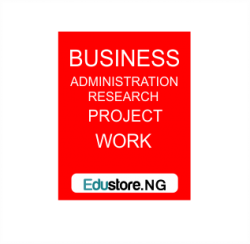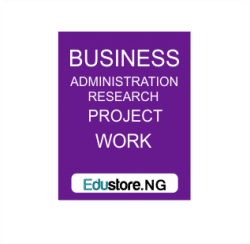APPRAISAL OF THE ROLE OF MANAGEMENT INFORMATION SYSTEM IN ENHANCING ORGANISATIONAL PERFORMANCE IN ECO BANK LIMITED, KADUNA
TABLE OF CONTENT
Title page – – – – – – – – – i
Declaration – – – – – – – – – ii Approval page – – – – – – – – iii
Dedication – – – – – – – – – iv
Acknowledgement – – — — – – – – v
Abstract – – – – – – – – – vi
Table of contents – – – – – – – – vii
CHAPTER ONE: INTRODUCTION
1.1 Background to the study – – – – – – – 1
1.2 Statement of the problem – – – – – – – 4
1.3 Objective of the study – – – – – – – 6
1.4 Significance of the Study – – – – – – – 6
1.5 Research Questions – – – – – – – – 7
1.6 Scope of the study – – – – – – – – 8
1.6 Limitation of the study – – – – – – – 8
CHAPTER TWO: Literature Review
2.1 Introduction – – – – – – – 9
2.2 Management Information System – – – – – -10
2.3 The Nature of data, Information Knowledge and Communications 14
2.4 Management and Decision Making the use of MIS at work – 16
2.5 Characteristics of Management Information System- – – 18
2.6 Effectiveness of Management Information System- – – 21
2.7 The Human Factor in Information processing- – – – 24
2.7.1 Top-Down Vs Bottom-Up Approach to MIS Development – 28
2.8 Evaluating the Security of information System- – – – 29
CHAPTER THREE: Research Methodology
3.1 Introduction – – – – – – – 32
3.2 Research design – – – – – – 23
3.3 Area of study – – – – – – – – 23
3.4 Population of the study – – – – – – 33
3.5 Sample size and sampling technique.- – – – – 33
3.6 Instrument for data Collection – – – – – 33
3.7 Validity of Instrument – – – – – – 35
3.8 Reliability of the instrument – – – – – 35
3.9 Method of Data Collection – – – – – – 35
3.10 Method of data analysis – – – – – – 36
CHAPTER FOUR: Data Presentation and Analysis
4.1 Introduction – – – – – – – – 38
4.2 Characteristics of respondents – – – – – 38
4.3 Data Analysis – – – – – – – 40
4.4 Summary of the Findings – – – – – – 46
4.5 Discussion – – – – – – – – 47
CHAPTER FIVE: Summary, Conclusion and Recommendation
5.1 Summary – – – – – – – – 48
5.2 Conclusion – – – – – – – – 49
5.3 Recommendation – – – – – – – 50
Bibliography – – – – – – – 53
Appendix – – – – – – – – 55
CHAPTER ONE
INTRODUCTION
1.1 BACKGROUND OF THE STUDY
The basis for all management information system is a computer system. Computer have transformed the business world as we know it, whether it’s a small business that uses computers for keeping inventory or accounting records of it’s operations or large businesses that uses computers for about every operations, computers are here to stay. Computers can take a business one step further, especially in the case of small business owners since business represents more than half of the economy.
By way of definition, a computer system is an electronic device that accepts data, processes the data in accordance with user instruction ( program) and generates results. It consists of input, output, storage and processing units. It is a functional unit that can perform substantial computations, including numerous arithmetic and logical operations. Based on classification, a computer system can be classified based on size, purpose, technology.
Oriha (2007) describes computer technology as rapidly advancing and innovations in the business world are constantly emerging while related cost in operation drops. The fast changing business world and the need for managers to be innovative, creative and be efficient makes the computer a vital instrument to reckon with in this 21st century. Computers and other communication equipments have made it possible to combine jobs which were previously carried out separately. Before the invention of computer system and its application to business operations, data collected for business purpose were processed and manipulated manually. This on its own has a lot of drawbacks to the effective running of business activities. During this period, data generated were recorded on paper, stored in filling cabinets and processed manually using simple procedures and office equipments such as typewriter, calculators, duplicating machines and so on.
This challenge of slow pace in information processing and the desire to have an information base that can respond almost immediately to management information need has led to the development of management information system. This is a system or process that provides the information necessary to manage an organization effectively. The challenges to establishing and implementing an effective management information system are novel and difficult, but not unyielding. The application of organizational development techniques holds great potential to surmount these obstacles and may provide organizations with significant advantages from developments in computing technology in the twenty first century. Evidence suggests that leading edge organizations are turning towards an integrated approach to Information Research Management (IRM).
Moga (2007) sees information system as a mechanism to ensure that information is available to managers in the form they want it and when they need it. It is designed to support their work through providing relevant information for their decision making,.
The benefits that advances in computer and information system technology offer to organizations in the 21st century seem indisputable, but whether organizations will actually achieve them, however, seems very much in question. While the foundation for this philosophy (MIS) rests on a strategy for integrating useful changes in computing technology into organizations, management information system must also encompass managerial and policy components. This is why a tripartite approach to information system adoption and implementation focusing on the technical, managerial, and policy dimensions.
Management Information System and the information it generates are generally considered essential components of prudent and reasonable business decisions. The importance of maintaining a consistent approach to the development, use and review of management information system within the institution must be an on-going concern for any serious institution.
1.2 STATEMENT OF THE PROBLEM
Survival in the very competitive and constantly changing business environment remains a key in modern banking system operations. Business has evolved together with the history of man and the scope is continually increasing both in size and complexity. This has opened the quest for business owners to constantly search for easier means of exchanging and generating timely and relevant information. The delay witnessed in gathering and generating this information and the reduction in its relevance has been a major problem. Some unavoidable errors due to human factors in the manual data processing is also a great problem and this have the capacity of limiting the effectiveness of the decision or render the information useless.
Business like any other profession also needs documentation of relevant transactions for reference and development purposes. It therefore becomes necessary for a business to have a tool it can use to store, transfer and retrieve information when needed at a reasonable pace of time. This important requirement of business has not been enhanced greatly with the manual means of business operation.
Other problem associated with manual information processing includes:
– High and excessive cost of generating and processing data. This aggravates the aggregate operating cost and limits operational efficiency.
– Unnecessary delay and waste of both time and resources. Customers are delayed as they spend much hours staying on queue and eventually offered poor and questionable service.
– There are also high and unprecedented records of litigations between customers and businesses. This was as a result of errors in the manual processing of data.
1.3 OBJECTIVES OF THESTUDY
The major purposes of this research work include the following:
1. To determine whether Management Information System application and enhancement to existing systems adequately support corporate goal.
2. To determine the real time in change in information policy affecting change in corporate organization?
3. To examine the corporate posture of the organization by the application of management information system.
4. To examine the relationship between quality information and decision making
1.4 SIGNIFICANCE OF THE STUDY
The significance of this study are as follows;
– The study will help educate management, workers and other connected persons who have stake their resources and livelihood on the organization as they would remain at information equilibrium.
– The study will also be of great usefulness to students carrying out a further research on this topic or related field.
– Information provided and stored concerning staff, customers, production, marketing, accounting and so on can easily be retrieved when needed through this study.
– To various organizations, this study will serve as a form of review or appraised of the use of computer in business operations.
– To the general public, the research is very useful to the extent that it will improve their understanding of the impact of computer as the basic for management information system on business operations.
1.5 RESEARCH QUESTIONS
The following are the research questions which the research work would seek to answer:
– Does management information system application and enhancement to existing system support the organization corporate goal?
– To what extend does change in information policy affect change in corporate organization?
– What is the relationship between corporate posture of the organization and its application of MIS?
– What is the relationship between quality information and effective decision making in MIS?
1.6 SCOPE OF THE STUDY
The application of management information system is practicable in both service and manufacturing sector. However, for the purpose of this study, Eco Bank limited, Kaduna south as one of the active participants in the service industry is chosen. The study covers a time from 2002 – 2012
1.7 LIMITATION OF THE STUDY
The study limited to the data and information made available by the bank. And this includes the following:
– Time constraint with respect to gathering needed data for the research work.
– The unwillingness of some staff to reveal some information due to fear of revealing to competitors is also a limitation.
– Finance: Insufficient finance lead to challenges to effectiveness of this research work.
However, all these limitations are mot given as a plat form to reduce the intellectual acceptance and provisional guidance that the research offers
DOWNLOAD COMPLETE WORK- For Reference Only: Materials are for research, citation, and idea generation purposes and not for submission as your original final year project work.
- Avoid Plagiarism: Do not copy or submit this content as your own project. Doing so may result in academic consequences.
- Use as a Framework: This complete project research material should guide the development of your own final year project work.
- Academic Access: This platform is designed to reduce the stress of visiting school libraries by providing easy access to research materials.
- Institutional Support: Tertiary institutions encourage the review of previous academic works such as journals and theses.
- Open Education: The site is maintained through paid subscriptions to continue offering open access educational resources.






